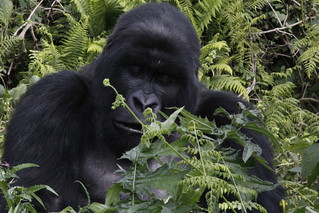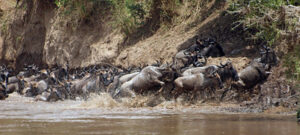The greatest migration of wildebeest of animals all over the world takes place in the east African countries of Tanzania and Kenya in parks like masai mara national reserve of Kenya, Serengeti national park of Tanzania, Ngorongoro conservation area of Tanzania and the nearby places. The movement of these wildebeest include the river crossing of both crocodiles feasted rivers of river Grumeti and river Mara while searching for the green pastures while following the rainfall season.
Below are the five major factors that determine the movement of wildebeest from southern Serengeti at Ndutu conservation area and at masai mara national reserve of Kenya before moving back to the southern Tanzania to start the circle again. The highlight of the entire great migration of the wildebeest is the crossing of mara river. Even though, beside mara river crossing, the entire migration experience is one to be cherished and you shouldn’t plan to miss out any of the experience.
Let us have a look at factors that do influence the wildebeest great migration from Tanzania to kenya. We shall also suggest for you the suitable safaris that you can take if interested in witnessing this great adventure of animal moving. Where possible we will discuss the estimated region of where wildebeest will be at a particular time of the year. Let’s go;
The rainfall season variation
One of the major reasons why wildebeest together with other herbivores migrate is to search for the new fresh grazing areas. When rain falls, new green grazing area grow which leads to the wildebeest to move in area with the new green pasture. It is also believed that the wildebeest have the capacity to sense rainfall in over 50 kilometers from where they are which determine where they will proceed next.
In some instance when falls in area where the wildebeest are already concentrated, they might choose not to proceed with the migration hence affecting the time when they will be in the next destination. When the dry season starts early in an area where the wildebeest are concentrated, they will resort into migrating early to search for a fresh grazing area and this will mean that might have to find wildebeest at the stage you don’t expect them to be.
On the other hand, heavy rainfall can negatively affect the migration by delaying some movements like river crossing. This is how heavy rainfall can delay the great wildebeest migration.
Disrupting river crossing
The highlight of the great wildebeest migration is the crossing of crocodile-infested river Mara. However, the falling of heavy rains can bring about heavy currents rendering the river crossing very dangerous to the wildebeest resulting into the delayed crossing hence postponing the experience to future date
Nutrient deficiency and dilution
The heavy rain can dilute the nutrients in grasses making it less favorable especially for the pregnant wildebeest and the newborn calves who needs the nutrients in plenty.
Habitat damage
Flooding caused by heavy rain can damage the riverbanks and grassland, making them less suitable for the wildebeest grazing and breeding
Reproduction cycle
Synchronized calving. The migration cycle is closely tied to the calving season that take place between January and march of every year in southern Serengeti, Ndutu conservation area
Survival advantage: over 8000 newborn wildebeest are produced every day, the reproduction season of wildebeest coincide with that of big cats that flock the Ndutu area to feast on these vulnerable newborn wildebeest
Nutrition need: the reason why the calving season is in southern Serengeti is not accidental, the pasture in this area is highly nutrient rich which makes it favorable for the newly born wildebeest
Predator avoidance
The presence of wildebeest attracts a lot of big cats in the area that come to feast on the wildebeest. Moving in a huge group is one of the defensive mechanisms used by the wildebeest to safeguard themselves against the charging predators. Wildebeest have a tendency of forming a circle while keeping the most vulnerable in the middle to safeguard them against the wildebeest.
Search for the food and water
The primary driver for wildebeest migration is a need to find a new grazing area with fresh food and water. The seasonal change greatly affect the availability of food in some area which forces the wildebeest to move to a new grazing area where there is fresh grass and water abundancy
The best wildebeest vacation safari packages
10 Day Wildebeest and gorillas vacation safaris

Embark on a captivating journey through the heart of East Africa as we invite you to explore the enchanting landscapes, vibrant cultures, and rich biodiversity of Rwanda and Tanzania. This meticulously crafted 10-day itinerary promises an immersive experience, seamlessly blending the awe-inspiring encounters with gorillas
| TRIP DETAILS |
| REQUEST INFO |
6 Day Wildebeest and gorilla trekking safari

Book 6 Days Ngorongoro crater visit and Rwanda gorilla trekking to explore Tanzania & Rwanda on an Africa Safari experience tailored by Active African vacation the leading Safari operator in Uganda. The 6 Days Tanzania Rwanda Safari takes you to the great Ngorongoro crater reserve for an amazing wildlife experience.
| TRIP DETAILS |
| REQUEST INFO |
7 Day Rwanda-Tanzania vacation safari

Depending on the degree of lodging, the time of year, and the particular parks and activities included a 7-day safari in Rwanda and Tanzania might have somewhat different costs. Along with activities to do in every park, below is a sample schedule including expected expenses for middle-class, budget, and luxury alternatives.
| TRIP DETAILS |
| REQUEST INFO |


